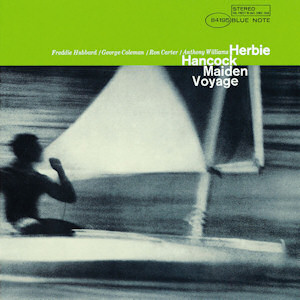
Maiden Voyage is the fifth album led by jazz musician Herbie Hancock, and was recorded by Rudy Van Gelder on March 17, 1965, for Blue Note Records. It was issued as BLP 4195 and BST 84195. Featuring Hancock with tenor saxophonist George Coleman, trumpeter Freddie Hubbard, bassist Ron Carter and drummer Tony Williams, it is a concept album aimed at creating an oceanic atmosphere. As such, many of the track titles refer to marine biology or the sea, and the musicians develop the concept through their use of space. The album was presented with the Grammy Hall of Fame Award in 1999.

Seven Steps to Heaven is the eighth studio album on Columbia Records by jazz musician Miles Davis, released in 1963, catalogue CL 2051 and CS 8851 in stereo. Recorded at Columbia's 30th Street Studios in Manhattan, and at Columbia Studios in Los Angeles, in sessions recorded in April of 1963, and May of 1963. It presents the Miles Davis Quintet in transition, with the New York session introducing the rhythm section of Herbie Hancock, Ron Carter and Tony Williams, who would become Davis' regular sidemen for the next five years. Upon release, the album was Davis' most successful on the Billboard pop LPs chart up to that point, peaking at number 62.
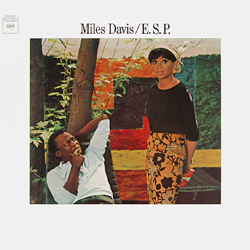
E.S.P. is an album by Miles Davis, recorded on January 20–22, 1965 and released on August 16 of that year by Columbia Records. It is the first release from what is known as Davis's second great quintet: Davis on trumpet, Wayne Shorter on tenor saxophone, Herbie Hancock on piano, Ron Carter on bass, and Tony Williams on drums. The album was named after a tune by Shorter, and was inspired by the fact that, "since Wayne Shorter's arrival, the five members of the quintet seemed to communicate by mental telepathy."

Miles Smiles is an album by jazz musician Miles Davis, released on February 16, 1967 on Columbia Records. It was recorded by Davis and his second quintet at Columbia 30th Street Studio in New York City on October 24 and October 25, 1966. It is the second of six albums recorded by Davis' second great quintet, which featured tenor saxophonist Wayne Shorter, pianist Herbie Hancock, bassist Ron Carter, and drummer Tony Williams.
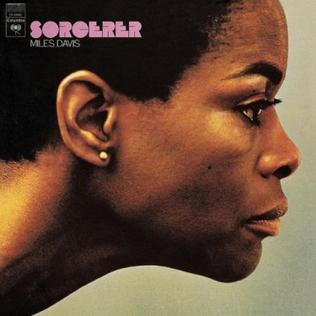
Sorcerer is an album recorded in May 1967 by the Miles Davis quintet. It is the third of six albums that this quintet recorded. It also includes one track from a 1962 session with vocalist Bob Dorough, which was the first time Wayne Shorter recorded with Davis. Davis does not play on the second track, "Pee Wee". The album's cover is a profile photo of actress Cicely Tyson, who at the time was Davis's girlfriend.
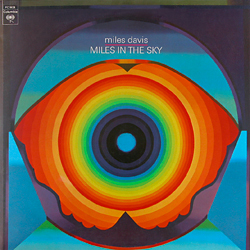
Miles in the Sky is a studio album by American trumpeter and composer Miles Davis, released on July 22, 1968, by Columbia Records. It was the last full album recorded by Davis' "Second Great Quintet" and marked the beginning of his foray into jazz fusion, with Herbie Hancock playing electric piano and Ron Carter playing electric bass guitar on opening track “Stuff”. Additionally, electric guitarist George Benson features on “Paraphernalia”.

The Complete Live at the Plugged Nickel 1965 is a live box set of the Miles Davis Quintet, recorded on December 22 and 23, 1965. First released in Japan in March 1992 by Sony Records as a 7 disc set, it was re-released on Legacy Records in July 1995 as an 8 disc set. In conjunction with Legacy, Mosaic Records released a 10 LP set. It was re-released as an SA-CD Box in October 2023 in a limited edition of 1500 by Sony Japan for Tower Records Japan. It comprises recordings of seven performance sets over the two nights by the second great Davis quintet at the now-defunct Plugged Nickel nightclub in Chicago. A single-disc sampler, Highlights from the Plugged Nickel was released by Legacy on November 14, 1995, and was reissued on February 1, 2008.

The Swing of Delight is a 1980 double album by Carlos Santana. It was released under his temporary Sanskrit name Devadip Carlos Santana, given to him by Sri Chinmoy. It peaked at #65 on the charts.

A Tribute to Miles is a tribute album recorded by the then surviving members of the Miles Davis "Second Great" Quintet: pianist Herbie Hancock, saxophonist Wayne Shorter, bassist Ron Carter and drummer Tony Williams. Taking the Davis role was trumpeter Wallace Roney.

Quartet is the thirty-fourth album by jazz pianist Herbie Hancock, featuring a quartet with trumpeter Wynton Marsalis, bassist Ron Carter and drummer Tony Williams. It was originally issued in Japan on CBS/Sony, and later given a US release by Columbia.

Circle in the Round is a 1979 compilation album by jazz musician Miles Davis. It compiled outtakes from sessions across fifteen years of Davis's career that, with one exception, had been previously unreleased. All of its tracks have since been made available on album reissues and posthumous box sets.

Water Babies is a compilation album by American jazz trumpeter Miles Davis. It compiled music Davis recorded in studio sessions with his quintet in 1967 and 1968, including outtakes from his 1968 album Nefertiti and recordings that foreshadowed his direction on In a Silent Way (1969), while covering styles such as jazz fusion and post-bop. Water Babies was released by Columbia Records in 1976 after Davis had (temporarily) retired.

V.S.O.P. is a 1977 double live album by keyboardist Herbie Hancock, featuring acoustic jazz performances by the V.S.O.P. Quintet, jazz fusion/ jazz-funk performances by the ‘Mwandishi’ band and The Headhunters. The concert was advertised as a "Herbie Hancock Retrospective," and Miles Davis, who was several months into his temporary retirement, was advertised as playing with the V.S.O.P. group. According to concert attendees, on the night of the show a handwritten sign was posted on the lobby door announcing that Davis would not be playing, but that Hubbard would be appearing instead.

'Four' & More: Recorded Live in Concert is a live album by Miles Davis, recorded at the Philharmonic Hall of Lincoln Center on February 12, 1964 and released two years later. Two albums were assembled from the concert recording: the up-tempo pieces were issued on this album, while My Funny Valentine consists of the slow and medium-tempo numbers.

The Complete Studio Recordings of The Miles Davis Quintet 1965–1968 is a box set of six CDs covering the work of Miles Davis and his critically acclaimed second great quintet which featured Wayne Shorter, Herbie Hancock, Ron Carter and Tony Williams.

Miles in Tokyo is a live album recorded on July 14, 1964, by the Miles Davis Quintet at the Tokyo Kōsei Nenkin Kaikan, Shinjuku, Tokyo, Japan. It was released in the United States on CD in 2005 and is the first recording of Davis in Japan. It is the only album to showcase an early incarnation of his Second Great Quintet featuring Sam Rivers on tenor saxophone, following George Coleman's departure; after this, Wayne Shorter's appointment completed the classic lineup which recorded such albums as ESP and Miles Smiles, through to Miles in the Sky.

Miles Davis' Greatest Hits is a compilation album by Miles Davis originally released in 1969 and re-released in 1997 on CD with different recordings of tracks 3, 4 and 8.

Directions is a compilation album by American jazz musician Miles Davis, released in 1981 by Columbia Records. It collects previously unreleased outtakes that Davis recorded between 1960 and 1970. Directions was the last of a series of compilation albums—mostly consisting of, at that time, previously unreleased music—that Columbia released to bridge Davis' recording hiatus that ended with the Man with the Horn in July 1981.

Live at the 1963 Monterey Jazz Festival is a live album by Miles Davis recorded on September 20, 1963 and released July 31, 2007. Davis searched for new musicians for his quintet, after splitting with saxophonist John Coltrane in 1960. The new quintet consists of saxophonist George Coleman, pianist Herbie Hancock, bassist Ron Carter and drummer Tony Williams. It was recorded at the Monterey Jazz Festival in the early fall of 1963.
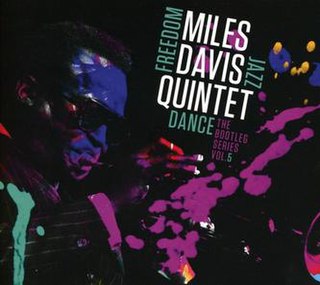
Miles Davis Quintet: Freedom Jazz Dance: The Bootleg Series, Vol. 5 is a 3-CD compilation that collects studio recordings by jazz trumpeter Miles Davis that were recorded between 1966 and 1968. The album contains remastered versions, alternate takes, and conversations among the musicians.




















